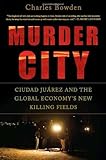Murder City
 Murder City is already a few years behind in the story of the U.S.-Mexico border. Charles Bowden has already published another book about Ciudad Juárez, and I’m certain other journalists have also been doing yeoman’s work to keep tabs on the story. In the meantime, murder in Juárez has marched on, doubletime (time considered as a map of the disappeared).
Murder City is already a few years behind in the story of the U.S.-Mexico border. Charles Bowden has already published another book about Ciudad Juárez, and I’m certain other journalists have also been doing yeoman’s work to keep tabs on the story. In the meantime, murder in Juárez has marched on, doubletime (time considered as a map of the disappeared).
But I’d like to pause a moment to appreciate the book. It begins as a year-in-the-life of Ciudad Juárez, but not just any year. In 2007 Juárez already had had more murders than most cities in the world, but in January 2008 the murder rate spiked; by December it had increased five-fold (and that record number of murders has since been eclipsed). Bowden says in the afterword to Murder City that it was because of the murder spike early in the year that he decided to chronicle the year in its entirety. To represent that chronicling, his reporting is in present tense, life-as-it’s-lived in loose chronology and in dust, heat, fear, and awe at what he witnesses and hears. Woven into the story are several of his previous years’ magazine pieces (notably this one from Harper’s). However, as summer comes, as the murder rate increases, as the city disintegrates, Murder City does too. What had begun as a chronicle of a year ends in the hot July sun with Bowden admitting that he can’t take it anymore. All that torture, all that death: Ciudad Juárez had beat him.
Murder City illustrates the emotional reality of reporting. It puts down a marker and says that it is impossible—and I expect Bowden would say immoral to try—to separate oneself from one’s subject. The emotional weight and consequence of horror are themselves facts worth reporting.1 If you read the book, you’ll get plenty of facts about Juárez, and you’ll hear plenty of theories about Juárez (though none Bowden himself subscribes to), but you’ll mostly be confronted with the enormity of Juárez. Bowden asks his readers to look at the city—he doesn’t ask them to comprehend it.2
1 Becoming overwhelmed by the stories one tells is something Bowden has written about before. Thinking on that essay today, I was reminded of this essay by Mac McClelland about the post-traumatic stress disorder she earned while reporting about rapes in Haiti. Both writers share an admirable commitment to their subjects and, it would seem, in their youths, a self-destructive blindness to their own limits. If they haven’t already, I think they should probably meet for drinks.
2 The opacity of meaning is reflected in the prose. Take Bowden’s adaptation of William Carlos Williams’s “The Red Wheelbarrow”:
So much depends upon a decapitated corpse with the head in a black daypack in the white heat of June.
This is so far removed from Williams’s rumination on rural life that it’s almost parody. But here the gesture is the same: It’s enough to acknowledge the value of a thing, whether the thing be a wheelbarrow or a corpse, without enumerating its value. To say what it is that depends on the thing is an exercise left to the reader.
However, not too many pages later, Bowden takes up the phrase so much depends again, but he turns it into a refrain repeated often enough that it loses connection with its inspiration. More, it loses meaning, or rather, it obstructs it:
So much depends on a blue carnation and fingers flicking messages into the void…. So much depends on the people in the neighborhood who say the gunshots could be heard for blocks and blocks…. So much depends on the worker… who is busy loading the van.
“So much depends,” Bowden says, but not you, reader, nor I could even begin to figure out what it is. In Murder City, all of Juárez is just as indecipherable.


